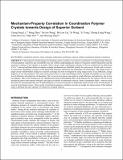Mechanism–property correlation in coordination polymer crystals toward design of a superior sorbent
Abstract
A methodology was developed to design superior sorbents of oxoanions. To integrate the high efficiency of chemisorption, selectivity, and recyclability into one sorbent, understanding the nature of oxoanions–sorbent interactions and the structural evolution of the sorbents is essential. Three cationic Ag(I) coordination polymers (CPs) are synthesized for dichromate (Cr2O72–) removal, and three distinct oxoanion-exchange mechanisms are identified, namely, the replacement, breath, and reconstruction processes, depending on the degree of framework distortion induced by the dichromate–CP interactions. The single crystal to single crystal transformation during the oxoanion exchange has been investigated by using single-crystal X-ray diffraction and energy-dispersive X-ray microanalysis. The replacement process, due to a weak chemisorption, shows excellent recyclability at the cost of reduction of efficiency and selectivity of adsorption. The reconstruction process may achieve a high efficiency and selectivity, but it loses recyclability. Due to the formation of a Ag–O(dichromate) bond and the breathing effect of the framework, the sorbent with the breath mechanism shows both superior efficiency and high recyclability in dichromate removal. The study of perrhenate (ReO4–) removal using the same CPs demonstrates that one CP performing the reconstruction process during dichromate removal turns to the breath process in removal of perrhenate anions. These results of mechanism–property correlation provide an insight into improvement of the methodology to fabricate a superior CP sorbent for oxoanion removal.
Citation
Li , C-P , Zhou , H , Wang , J-J , Liu , B-L , Wang , S , Yang , X , Wang , Z-L , Liu , C-S , Du , M & Zhou , W 2019 , ' Mechanism–property correlation in coordination polymer crystals toward design of a superior sorbent ' , ACS Applied Materials & Interfaces , vol. 11 , no. 45 , pp. 42375-42384 . https://doi.org/10.1021/acsami.9b16386
Publication
ACS Applied Materials & Interfaces
Status
Peer reviewed
ISSN
1944-8244Type
Journal article
Description
This work was financially supported by the National Natural Science Foundation of China (21571158 and 21771139), Tianjin Natural Science Foundation (17JCYBJC22800), and the Program for Innovative Research Team in University of Tianjin (TD13-5074).Collections
Items in the St Andrews Research Repository are protected by copyright, with all rights reserved, unless otherwise indicated.

